Score breakdown
Things we like
- Great value
- Fast and fun
- Exhaust toots
Not so much
- Native infotainment user interface
- Hollow grab handle
- Styling too much?
The 2021 Hyundai i30 Sedan N Line joined the line-up in mid-2020, some four years after the hatch variant came onto the scene.
But we might have known about it a little sooner. In early January 2020 – when I was mainly writing about modern classic cars and not keeping fully abreast of new-car market happenings – I was driving down the EastLink freeway in Melbourne when I spotted an unmarked police car.
I spent some time trailing the cop car because it was the first time I’d seen this particular sedan, sporting ‘pennant’ slash cuts down the side and an unusual boot design. I knew it was a police car, as there was no number plate surround, a weird aerial or two, some boxes and wires on the dashboard, and two men in short-sleeve shirts who stared at me intensely as I drove next to it for a closer look.
Six months later – and me now working on a news desk – we were sent press images for the i30 Sedan under embargo, and I had to come to terms with the fact that I’d seen an uncamouflaged Hyundai i30 Sedan undergoing testing and hadn’t realised it. So to say I have a troubled relationship with the car before I’ve ever driven it is an understatement.

The i30 Sedan before you is the N Line Premium variant. Anything from Hyundai wearing an ‘N’ badge denotes it as a full-fat performance variant – powerful engine, tuned suspension, sticky tyres, and a special interior. As Chris Thompson remarked in his review of the 2021 Hyundai i30 N Line hatch, anything with an ‘N Line’ badge translates to ‘N Lite’. So you can think of the car before you as the Smarter White i30 Sedan… but it has a bit more than just two per cent fat.
Being the Premium version, this is essentially the range-topping model before you move to the upcoming i30 Sedan N. Priced from $37,690 before on-road costs, the N Line Premium gets a 1.6-litre turbocharged four-cylinder petrol engine, sending 150kW and 265Nm to the front wheels through a seven-speed dual-clutch transmission.
Either a six-speed manual gearbox or the seven-speed automatic can be optioned with the i30 Sedan N Line, but the N Line Premium can only be had with the auto – helping to deliver the vehicle to 100km/h from a standstill in 7.6 seconds.
Pricing and Features

As well as a 25 per cent power bump over standard models, the N Line variants get larger brakes – up from 280mm to 305mm – while the N Line Premium gets heated and ventilated seats, and a 10.25-inch infotainment screen (up from 8.0 inches) with satellite navigation, DAB+ digital radio, Apple CarPlay and Android Auto, and all running through a Bose premium audio system.
A power sunroof, digital instrument cluster, auto-dimming mirror, front parking sensors, power driver’s seat adjustment and LED ambient interior lighting are also exclusive to the Premium variant, along with a leather interior, automatic wipers, wireless phone charging, rear parking sensors and a reversing camera.
On the outside you get 18-inch alloy wheels clad in Goodyear rubber, a more aggressive body kit, dual chrome oval exhaust tips, LED headlights and tail-lights, and black highlights.
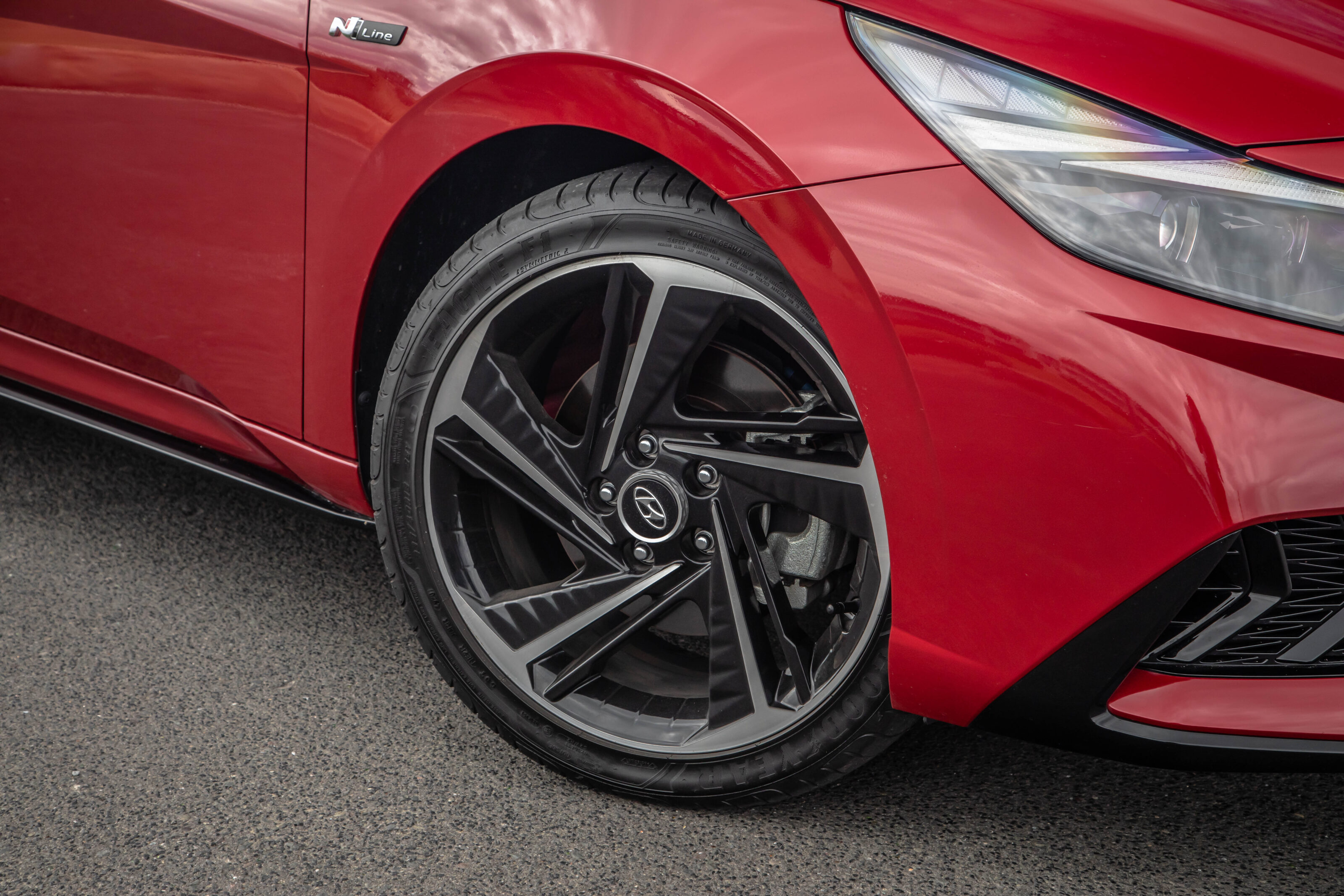
Compared to the ‘base’ i30 N Line hatch with automatic transmission for $31,420 before on-road costs, the range-topping i30 Sedan N Line Premium represents excellent value at $37,690 plus on-roads. It’s quite a jump in interior design, technology, and features.
And while not a direct comparison, it’s worth noting that the recently departed Hyundai Veloster Turbo Premium cost $42,410 before on-roads when optioned with an automatic – and you get a lot more car with the i30 Sedan N Line Sedan Premium.
Anything with an ‘N Line’ badge translates to ‘N Lite’. So think of the car as the Smarter White i30 Sedan … but it has more than just two per cent fat.
Comfort and Space
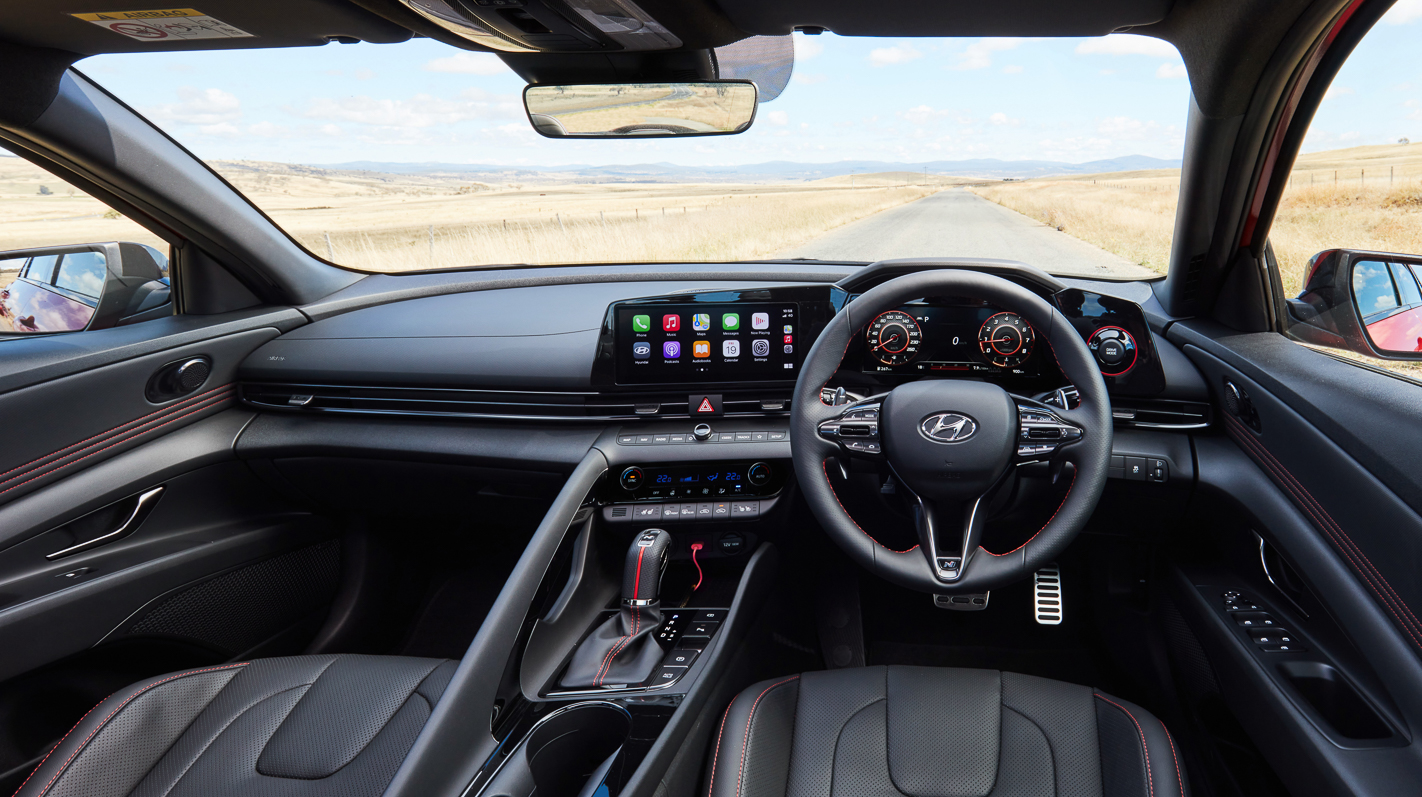
Spend some time behind the wheel, and you would be hard-pressed finding anything major to complain about inside the i30 Sedan N Line Premium. The design and technology will be more than enough for the car to feel fresh and up-to-date for the rest of this decade, and for the vast majority of people, this sedan has more than enough space.
Its 10-way power-adjustable driver’s seat enables a very comfortable position to be found, and the mixture of genuine and synthetic leather feels both supple and hardy – as if the upholstery will stand the test of time, like Mercedes’ famous MB-Tex. Without being overly firm, there’s extra bolstering, some N logos embossed into the seats and red contrast stitching to match the red highlights throughout the interior.

As with the outside of the car, inside you’ll find the cabin has quite a modern look too – almost to the point of being overdesigned. The driver-centric dash layout is appreciated, with sweeping lines providing a flowing visual frame at the upper edges. But while I liked the grab handle for the passenger in the centre console, the plastic itself felt a little hollow and uninsulated – especially noticeable considering almost all other cabin touchpoints feel high-quality and thoughtful.
It might not be the first choice of professional chauffeurs, but the i30 Sedan provides plenty of room in the back seat for adult passengers too. The lack of USB or 12-volt power outlets for second-row occupants seems like a bit of an omission in this day and age, but at least there are rear vents to keep everyone at a comfortable temperature. There is a decent amount of space in the boot, with 474 litres compared to just 395L in the i30 hatch.
On the road

Not that I recommend doing this, but close your eyes and I suspect most would have a hard time finding much of a difference between the Hyundai i30 Sedan N Line Premium and some of the smaller sedans offered by the likes of Audi, BMW, and Mercedes-Benz. The ride and handling – tuned specifically for “Australian conditions” – feel spot-on for a daily commuter car with a sporty flavour. It’s compliant and comfortable but has a sharp turn-in and reasonably flat cornering at speed.
There’s a real premium character that perhaps comes from the feeling of the car being finished. The driving experience doesn’t give the impression of cost-cutting or being put to market too early – there’s a sense of wanting to make the car as good as it could be that helps the Hyundai feel as if it’s nipping on the heels of a BMW 2 Series Gran Coupe.
What does betray the German car experience is cabin noise. Certainly not the worst I’ve experienced by any means, but there is a higher level of din than I’d prefer, and it could contribute to increased fatigue when driving longer distances.

The dual-clutch transmission can also suffer from a shuddery start at times, almost encouraging you to feed in more throttle when the light goes green and forcing you to lean into the car’s sporty flavour.
Having spent some time behind the wheel of a manual Veloster Turbo, I can say the seven-speed dual-clutch automatic in the i30 Sedan – when combined with a newer version of Hyundai’s 1.6-litre turbocharged powertrain – frankly makes a lot more sense. The closer gearing and the improved torque delivery from the engine really help to keep the car in its sweet spot, making the i30 very useable day-to-day, but ready to take on more demanding tasks at a moment’s notice.
Hit the almost comically large Drive Mode button to the right of the digital instrument cluster and the design of the gauges changes to a sporty red theme to let you know you’re ready to rock. And the car really does step up to the task. Its 0-100km/h time might not seem all that fast by today’s standards, but it’s brisk enough to satisfy a spirited drive on a winding road without ever feeling like there’s too much under your foot to send you over the edge. It’s quick, manageable, and most importantly: it’s fun.

What’s more, the exhaust note provides a surprisingly fruity soundtrack, which was unexpected but welcome. Under the right circumstances, the car will deliver a ‘brrt’ between gear changes, reminding you that this ain’t your aunty’s base-spec i30.
The slightly longer wheelbase does also change the car’s character when compared to the i30 hatchback. There’s less of that pointed dart feeling you get in the hatch, and more of a mature and confident footing around bends that adds to the driver’s belief in themselves and the car.
Perhaps the only annoyance was the difficulty I had using the infotainment system. It wasn’t as intuitive to navigate as others I’ve used, and I found myself concentrating on the screen trying to figure out the digital radio more than I was on the road, which led to my first drive being done in silence to avoid letting myself get into bother. No doubt five minutes of training by dealership salespeople would have you working it without issues, but I like to go in blind to see if someone of average intelligence can handle it.
Ownership

The Hyundai i30 Sedan N Line Premium comes with a five-year/unlimited-kilometre warranty and 12-month/10,000km service intervals – whichever comes first.
Up to 50,000km of pre-paid servicing can be included in the purchase for $1562.20 before on-road costs are added, equating to an average service cost of $312.44.
Hyundai claims fuel consumption of 6.8L/100km on standard unleaded petrol, but my time with the car had the average sitting at around 7.4L/100, thanks to some enthusiastic squirts during mainly suburban driving, with a bit of freeway time thrown in.
VERDICT
My relationship with the i30 Sedan may have started under unusual circumstances, but the car really impressed me. In spite of its edgy, in-your-face design, this car is mature, sophisticated and enjoyable to drive.
Not only do the ride, handling, engine performance and technology really propel the Hyundai to a step above, but the car feels as if it’s much more mature and sophisticated than, say, a Corolla sedan. The Hyundai is more on the same spiritual level as a Skoda Octavia, while offering arguably even better value for money. And the Octavia is a car known for being good value already, so that should tell you something.
It may be the four-door version of Hyundai’s small car – designed to compete against the Toyota Corolla and Volkswagen Golf – but in most dimensions, the i30 Sedan almost feels like it’s from the next segment up, as if it’s deserving of an i45 badge.
The Hyundai i30 Sedan N Line Premium could be the perfect solution for buyers who’ve decided they want a fast car for the first time – not some super high-powered German or Italian car. The N Line is lively, quick, and has a sure-footedness when being pushed that makes it easy to drive fast within the realities of driver skill and road law.
If you’re one of the dozen Aussies not looking to buy an SUV and you can get on board with the extroverted styling, the Hyundai i30 Sedan N Line Premium might surprise you. It’s practical, fun, and is a great deal at $37,690 plus on-roads.
In spite of its edgy, in-your-face design, this car is mature, sophisticated, and enjoyable to drive.
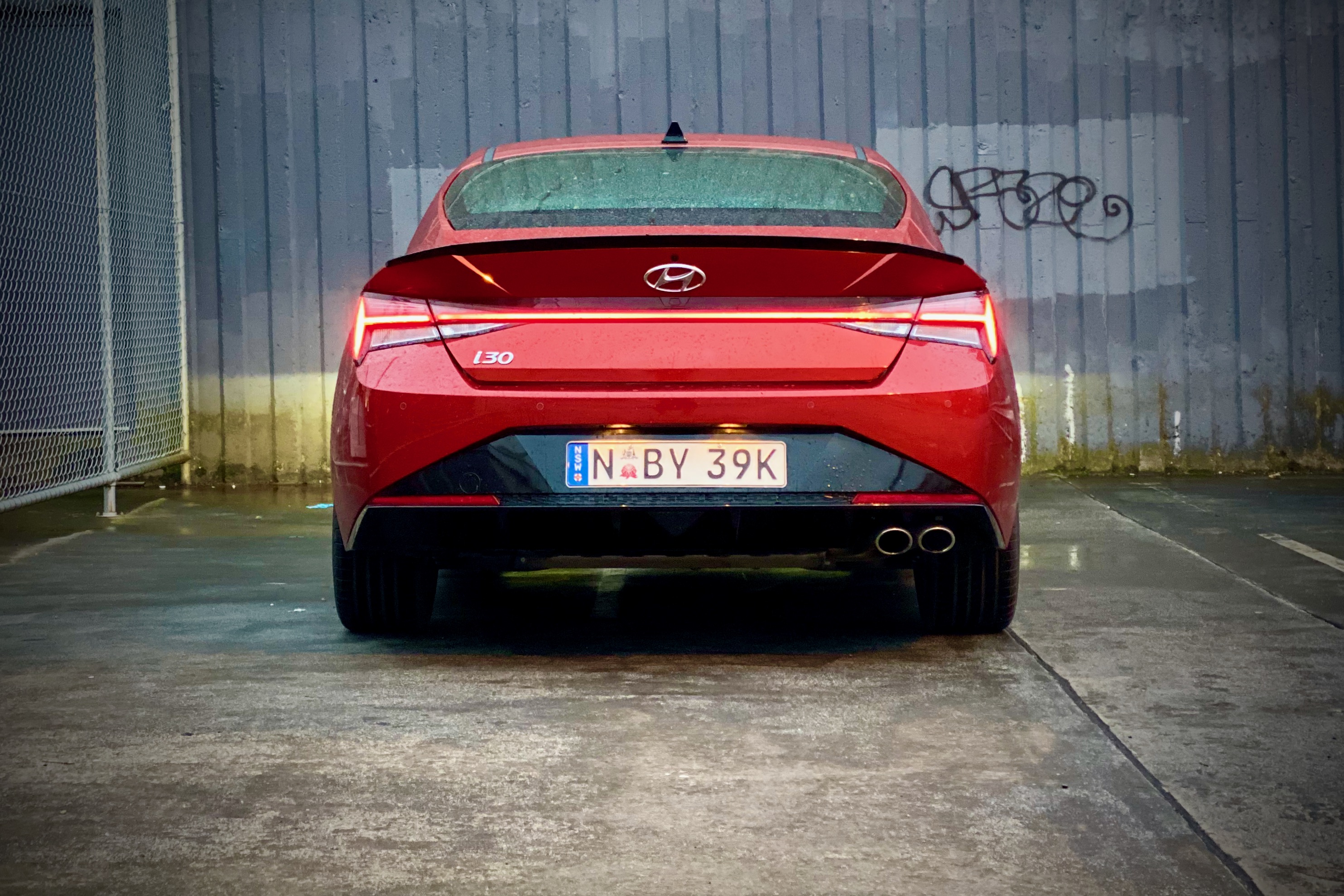
2021 Hyundai i30 Sedan N Line Premium specs
| Body | Sedan |
|---|---|
| Drive | Front-wheel drive |
| Engine | 1.6-litre turbo-petrol four-cylinder |
| Transmission | Seven-speed dual-clutch automatic |
| Power | 150kW @ 6000rpm |
| Torque | 265Nm @ 1500-4500rpm |
| Bore/Stroke | 75.6mm x 89mm |
| Compression ratio | 10:1 |
| 0-100km/h | 7.6 seconds (claimed) |
| Fuel consumption | 6.8L/100km combined (claimed) |
| Weight | 1340kg |
| Suspension | MacPherson strut front; Multi-link rear |
| L/W/H | 4675mm/1825mm/1430mm |
| Wheelbase | 2720mm |
| Brakes | 305mm ventilated discs front; 284mm solid discs rear |
| Tyres | 235/40R18 95Y Goodyear Eagle F1 Asymmetric 2 |
| Wheels | 18×8-inch alloys |
| Price | $37,690 plus on-road costs |
Flashback
Score breakdown
Things we like
- Great value
- Fast and fun
- Exhaust toots
Not so much
- Native infotainment user interface
- Hollow grab handle
- Styling too much?
We recommend
-
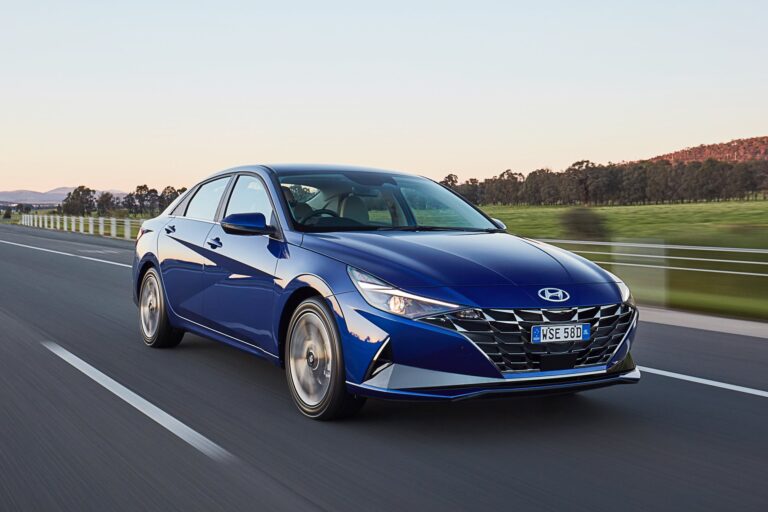 News
NewsHyundai i30 Sedan prices and specs revealed
Style, tech and safety gains for Hyundai’s smart new i30 Sedan
-
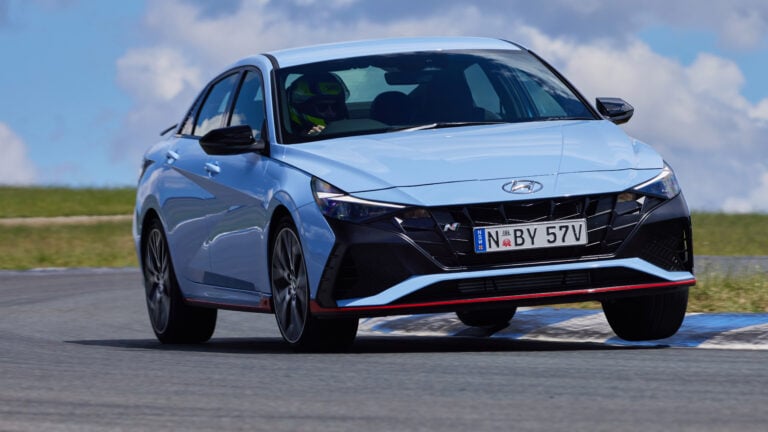 Reviews
Reviews2022 Hyundai i30 Sedan N review: Australian first drive
N Division’s latest offering might just be the most compelling one yet
-
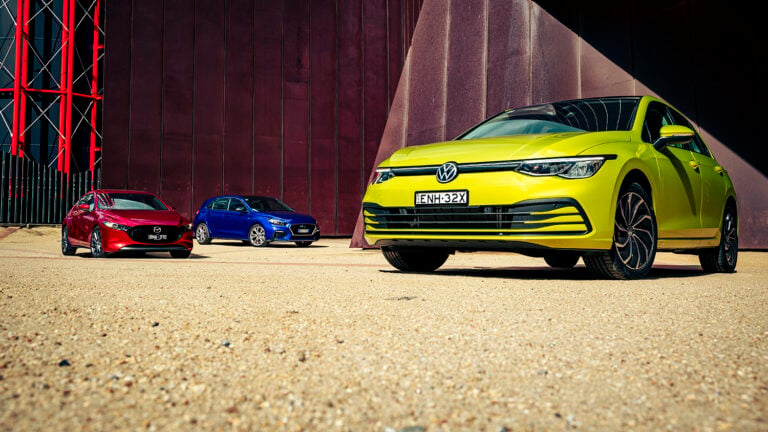 Comparisons
Comparisons2021 Volkswagen Golf vs Mazda 3 vs Hyundai i30
As Volkswagen reboots the Golf for an eighth time, two rivals hope to prove themselves the more compelling option






